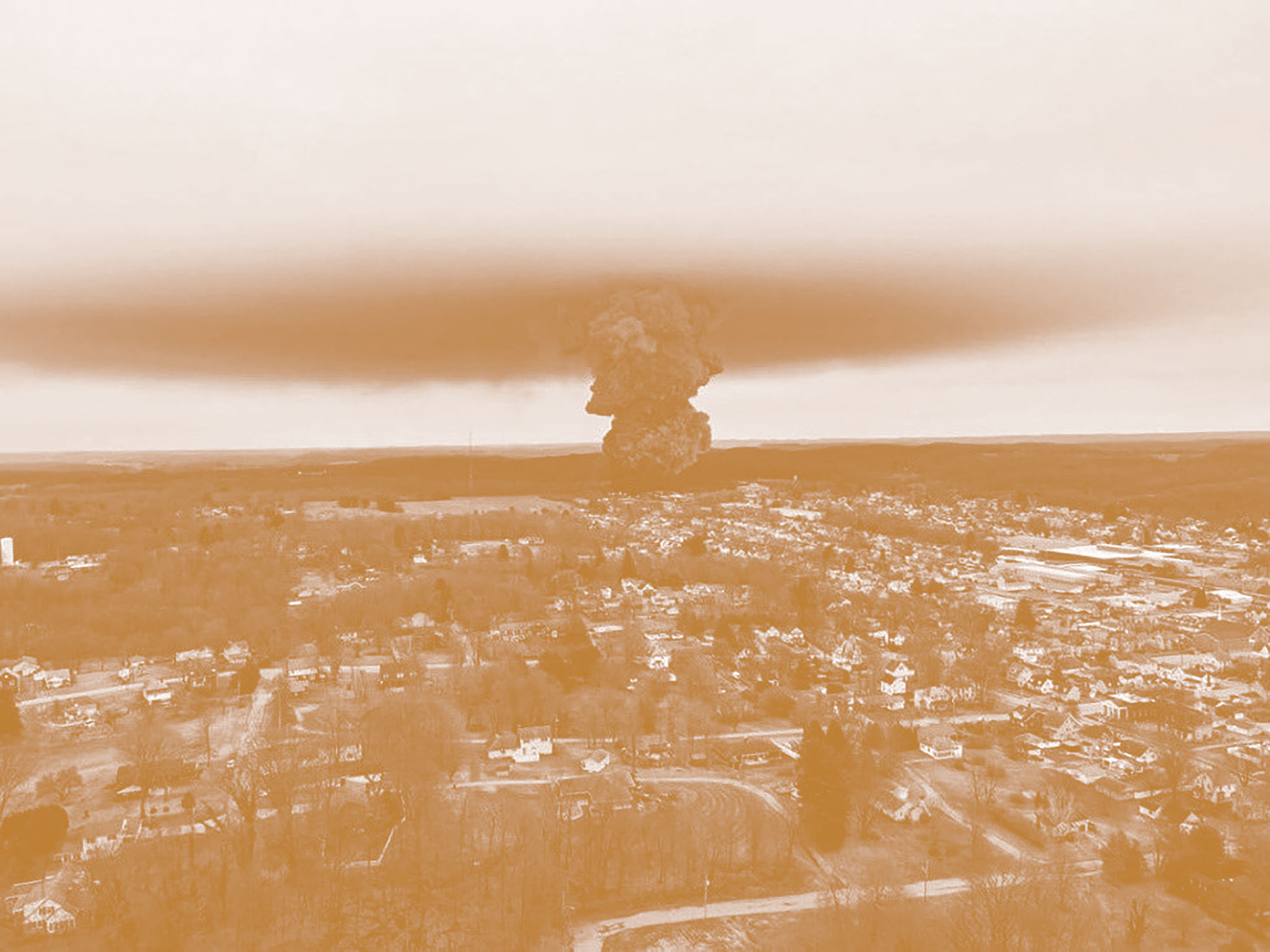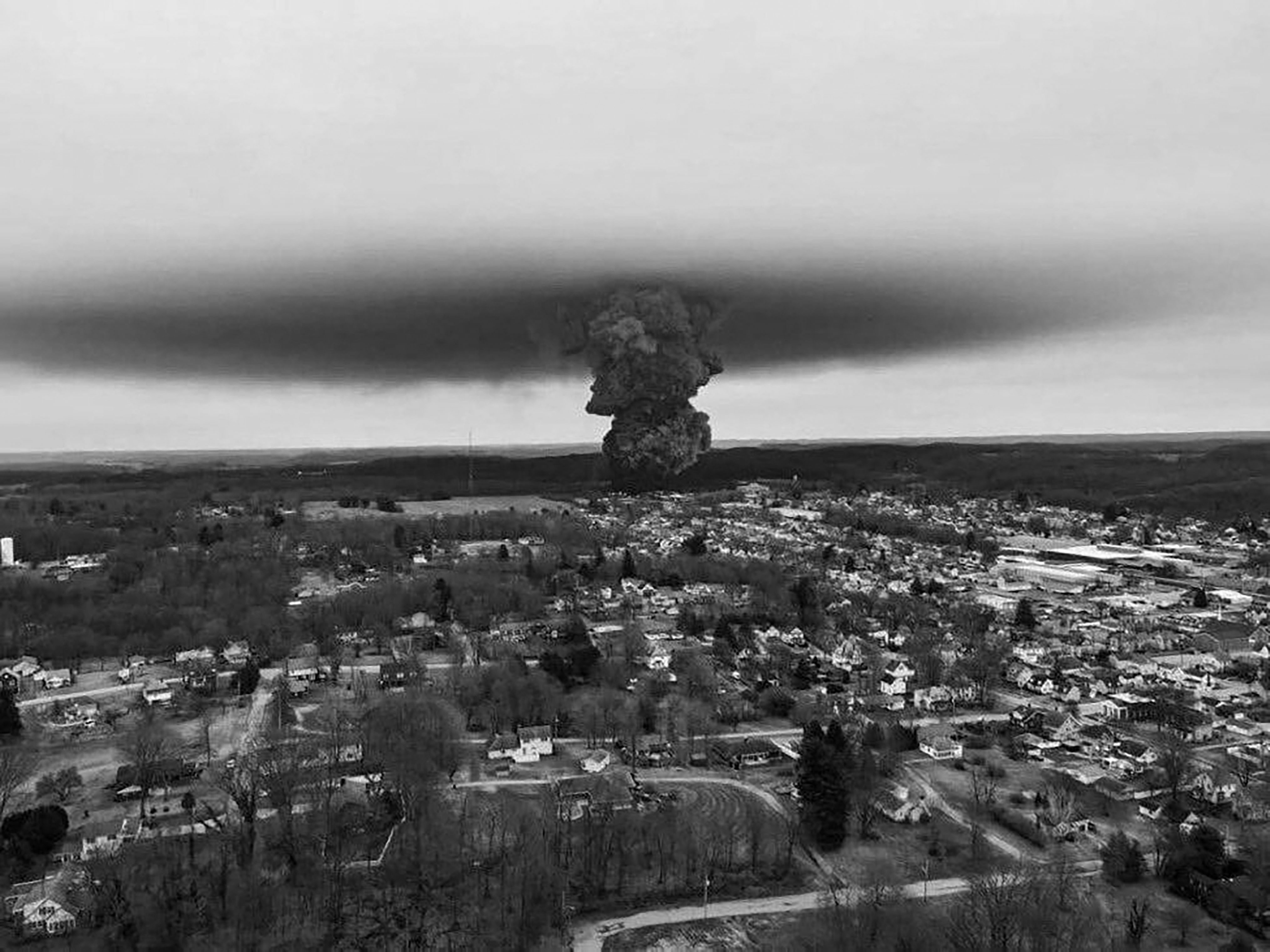March 19, 2023 / Cleveland, Ohio
Tizziana Baldenebro + Lauren Leving

A large black cloud of toxic chemicals as seen by a drone above the town of East Palestine, Ohio. © RJ Bobin.
On February 4, 2023, just over a month ago at the time of this writing, a Norfolk Southern freight train derailed in East Palestine, Ohio, a village ninety miles south-east of Cleveland—where we live—and fifty-one miles northwest of Pittsburgh, Pennsylvania. The freight carried, among other things, vinyl chloride, a chemical used in the production of the petrochemical polymer polyvinyl chloride, more commonly known as PVC. In a unilateral effort to contain the massive spill, local law enforcement, the fire department, Norfolk Southern, and state government lit a controlled fire without consulting the Environmental Protection Agency, residents of East Palestine, or national experts. In Cleveland, we paused, wondering if we would be affected by the resulting malevolent cloud or if our water drew from the now-contaminated Ohio River. We dwelled on the verisimilitude of the movie White Noise, recently filmed around Northeast Ohio, and were outraged by the bipartisan failures that brought us to this moment. We wondered if this was our Chernobyl. We were reassured, terrifyingly, that the airborne poisons were heading not toward us but east, past Pittsburgh, over central Pennsylvania and into New York, and that this cloud would disperse over the ocean. We learned that the watershed poison was also not heading toward us and was instead heading southwest, toward Cincinnati, cresting over Kentucky and under Illinois, where it would yield its toxic contents into the Mississippi River.
Perfected in the United States in the early 1900s, petrochemical polymers, collectively and commonly known as plastics, were embraced as revolutionary materials. Intended to protect the so-called “natural world” and decrease socioeconomic barriers to accessing goods previously only available to the wealthy, plastics were imagined to mimic the materials plundered from the earth, like ivory, coral, and tortoiseshell—and, in many cases, they succeeded. In this way, plastics entered the consumer market as finished goods, ready to use. Plastic thinking abandoned material lineages; readymade goods, conjured from a perceived nothingness, seemed to erase the toxic legacies of extraction—of people, labor, and land—entrenched in settler colonial material culture.
As plastics proliferated over the past century, alongside and in tandem with wars, viruses, and technological advancements, cultural attitudes shifted toward disposability, single-usage, and abstraction. Today, plastics exist as both a feared anathema and an accessible material for experimentation and social welfare. Acutely visible yet unsettlingly unseeable traces of plastics course through our veins, waterways, and air molecules. As in East Palestine, urgency emerges most often when toxins are perceivable, while passive pollutants pose silent dangers. The material exists all around us, simultaneously enabling and threatening every part of modern life. So, how can we live without plastics? But, also, how can we live without plastics? Each emphasis indexes a different set of concerns.
The following Sketches, emerging from a collaborative editorial process, have informed and continue to inform our way of thinking as we realize the exhibition Everlasting Plastics. Using the exhibition as a point of departure, we connected with scholars, poets, architects, activists, and artists to sketch on Everlasting Plastics, encouraging authors to dig deeper, to push at the project’s edges and rupture its boundaries, expanding the ideas and stakes of the exhibition. Through the resulting collection of ideas, brief outlines, and thoughts, we begin to form an epistemology of plastic. Texts build off of one another, contradict each other, and embrace the unfinished, creating a boundless space that demands a multiplicity of perspectives. We intend for these Sketches to illuminate and unsettle our relationships with plastic, shaping a more expansive way to think about the material, its evolution, and its uncharted lifespan.
While rooted in an examination of plastics, these Sketches also model a spectrum of methodologies that allow us to see what other materials, people, disciplines, legacies, and attitudes plastics entangle: some center a particular object, while others expand on a site; some stay with the human body, while others consider the relations plastics knot together and are knotted within. Without leveraging these ways of thinking to place demands on our systems of production and cycles of solution-driven waste management, toxicity levels will only continue to rise. This is already evident—in East Palestine, in the Texas-sized Great Pacific Garbage Patch, in our endocrine systems—and will only continue until we ultimately extinguish even the possibilities of new ways of living. Working closely with Isabelle Kirkham-Lewitt, Joanna Joseph, and Meriam Soltan, the brilliant editors at Columbia Books on Architecture and the City, we reframed sketching as a discursive process, as a way of writing and rewriting together—as a gesture in line with plastic’s unknown futures.
In ideating how these Sketches might emerge, we invited writers whose work expands notions of material relations, forefronts criticality and care, and heightens contradictions. We remain totally indebted to the work and thought of others, including Max Liboiron, who interrogates the colonial frameworks that inform contemporary research around plastic; Mel Y. Chen, who articulates a case for the animacy of matter, materials, and non-humans, allowing for more expansive kinships; Paul B. Preciado, who describes the plasticity of the body in relation to gender and sexuality; Fred Moten, who, in writing about plasticity as it relates to and is endured by the Black body, demonstrates how plastic thinking extends beyond material expertise; Vanessa Agard-Jones, who examines racialized negotiations between life and non-life; and Andrea Wolk Rager, whose course “Plastocene Era: Art, Plastics, and the Future of the Planet,” at Case Western Reserve University, carved space for us to reflect on this subject with the enthusiastic minds of students.See for instance Max Liboiron, Pollution Is Colonialism (Durham, NC: Duke University Press, 2021); Mel Y. Chen, Animacies, Racial Mattering, and Queer Affect (Durham, NC: Duke University Press, 2012); Paul B. Preciado, Testo Junkie, Sex, Drugs, and Biopolitics in the Pharmacopornographic Era (New York: Feminist Press, 2013); Fred Moten, “The Touring Machine (Flesh Thought Inside Out),” in Plastic Materialities: Politics, Legality, and Metamorphosis in the work of Catherine Malabou, eds. Brenna Bhandar and Jonathan Goldberg-Hiller (Durham, NC: Duke University Press, 2015); and Vanessa Agard-Jones, “Bodies in the System,” Small Axe 17, no. 3 (November 2013): 182–192.
We write this from Ohio, a state that leads in petrochemical polymer production; from within the United States of America, a country which sensationalized plastics; and from a generation that has repeatedly been told that it was possible to reduce, reuse, and recycle our way out of this crisis. Our hope is that Everlasting Plastics provides a shift in this tired rhetoric—that, through these Sketches, we expand our ways of thinking and allow for a more confrontational, more tangible, more social, more plastic approach.
See for instance Max Liboiron, Pollution Is Colonialism (Durham, NC: Duke University Press, 2021); Mel Y. Chen, Animacies, Racial Mattering, and Queer Affect (Durham, NC: Duke University Press, 2012); Paul B. Preciado, Testo Junkie, Sex, Drugs, and Biopolitics in the Pharmacopornographic Era (New York: Feminist Press, 2013); Fred Moten, “The Touring Machine (Flesh Thought Inside Out),” in Plastic Materialities: Politics, Legality, and Metamorphosis in the work of Catherine Malabou, eds. Brenna Bhandar and Jonathan Goldberg-Hiller (Durham, NC: Duke University Press, 2015); and Vanessa Agard-Jones, “Bodies in the System,” Small Axe 17, no. 3 (November 2013): 182–192.

